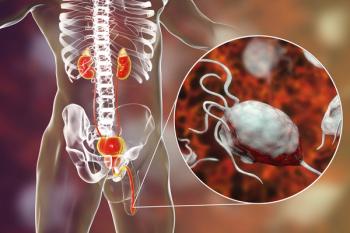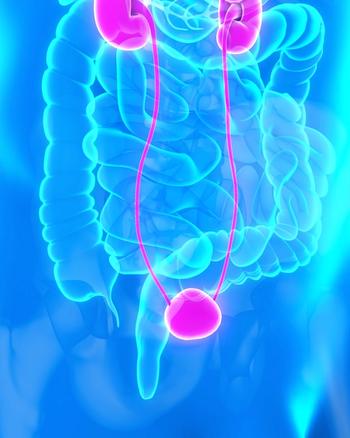
Progastrin-Releasing Peptide Levels Correlate With OS and PFS in LS-SCLC
Those with limited-stage small cell lung cancer who had elevated ProGRP levels at baseline had worse OS and PFS outcomes vs those with normalized levels.
Progastrin-releasing peptide (ProGRP) levels at baseline and following chemoradiotherapy correlated with progression-free survival (PFS) and overall survival (OS) outcomes in patients with limited-stage small cell lung cancer (SCLC), according to results from a study published in Lung Cancer.
At baseline, when patients had elevated levels of ProGRP, a median PFS of 12.2 months was observed compared with not reached (NR) for patients who did not have elevated levels of ProGRP (P = .006); the median OS was 29.3 months compared with NR (P = .001). In multivariable analyses, statistical significance was observed for both PFS (HR, 2.70; 95% CI, 1.16-6.29; P = .021) and OS (HR, 3.79; 95% CI, 1.44-9.99; P = .007).
Following chemoradiotherapy, patients who had elevated levels of ProGRP achieved a median PFS of 11.1 months compared with NR in those who did not have elevated levels of ProGRP (P = .006); the median OS was 30.6 months vs NR (P = .002). The multivariable analyses showed that the associations remained statistically significant for both PFS (HR, 2.64; 95% CI, 1.26-5.51; P = .010) and OS (HR, 2.73; 95% CI, 1.29-5.78; P = .009).
During chemoradiotherapy, 22.0% of patients had their ProGRP levels remain normal, 42.4% changed from elevated ProGRP levels to normal, 3.4% changed from normal to elevated, and 32.2% remained elevated. Notably, the 2 patients who changed from normal to elevated ProGRP levels were close to the cutoff value of 80 ng/L; neither had progressed or died at the time of analysis.
Those who had elevated ProGRP at baseline and normalized ProGRP following chemoradiotherapy achieved a median PFS of 49.3 months vs 7.8 months in those who had persistently elevated ProGRP (P = .003); the median OS was NR vs 30.5 months (P <.001). Associations for PFS (HR, 1.65; 95% CI, 1.21-2.26; P = .043) and OS (HR, 0.99; 95% CI, 0.94-1.04; P = .017) remained significant in multivariable analyses.
Regarding neuron-specific enolase (NSE), there were no associations between elevated NSE at baseline and PFS, with a median PFS of 15.9 months with elevated NSE vs 16.0 months with normalized NSE (P = .88), or OS, with a median OS of 33.3 months vs 41.6 months (P = .26).
Similarly, after chemoradiotherapy, no associations were noted between elevated NSE and PFS, with a median PFS of 10.9 months with elevated NSE and 38.4 months with normalized NSE (P = .31), and OS, with a median OS of 26.8 months vs 54.0 months (P = .11).
“This study aims to determine whether ProGRP levels before or after [chemoradiotherapy] are associated with [PFS] or [OS] in [limited-stage] SCLC,” wrote lead study author Miriam Grønberg, of the Department of Clinical Science at the University of Bergen in Bergen, Norway, with coauthors. “In conclusion, ProGRP levels before and after [chemoradiotherapy] were associated with both PFS and OS in [patients with limited-stage] SCLC receiving concurrent chemotherapy and [concurrent twice-daily thoracic radiotherapy], whereas NSE levels were not significantly associated with these treatment outcomes.”
A total of 89 patients from the Scandinavian randomized phase 2 THORA trial (NCT02041845), which compared 2 schedules of thoracic radiotherapy as treatment for those with limited-stage SCLC, were included in the analysis. Eligible patients were 18 years or older with an ECOG performance status from 0 to 2 and stage I to III disease per Tumor-Node-Metastasis version 7.
Of the patients analyzed, 66.3% had ProGRP measurements after chemoradiotherapy, 74.2% had NSE measurements after chemoradiotherapy, and 65.2% had ProGRP and NSE measurements after chemoradiotherapy.
Treatment consisted of 4 courses of platinum-etoposide chemotherapy for all patients, then they were randomly assigned, in a 1:1 ratio, to receive concurrent twice-daily thoracic radiotherapy at either 45 Gy in 30 fractions or 60 Gy in 40 fractions starting 21 to 28 days from the first chemotherapy course.
“…Additional larger studies are needed to confirm our findings, define the optimal cutoff value, and determine ideal timepoints of measurements,” concluded the study authors.
Reference
Grønberg M, Aanerud M, Halvorsen TO, Killingberg KT, Grønberg BH. Associations between progastrin-releasing peptide (ProGRP) and neuron-specific enolase (NSE) and survival in patients with limited-stage small cell lung cancer (LS SCLC) receiving chemoradiotherapy (CRT). Lung Cancer. 2025;207:108678. doi:10.1016/j.lungcan.2025.108678
Newsletter
Stay up to date on recent advances in the multidisciplinary approach to cancer.






















































































